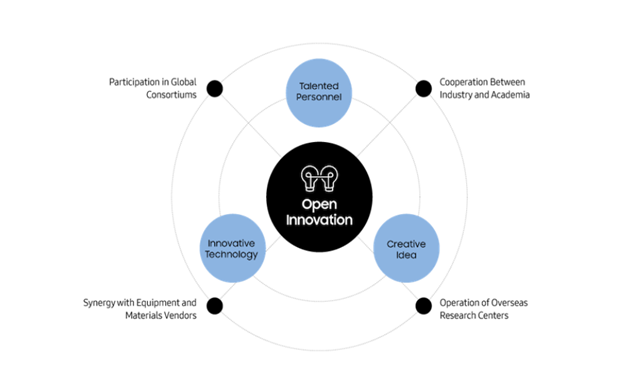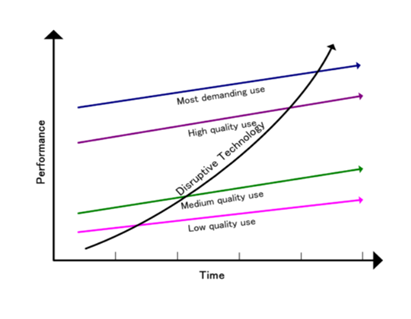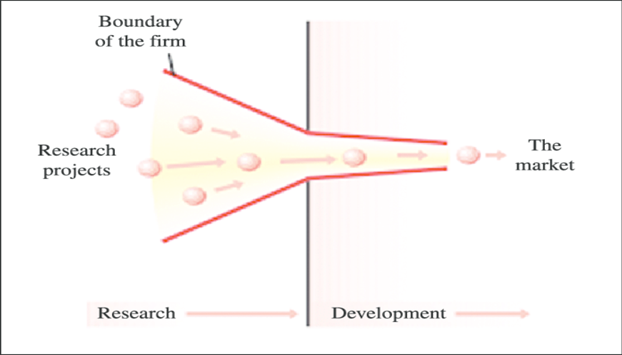Innovation management
Contents |
Abstract
This article is about innovation management in project.
Innovation management refers to the systematic process of managing and integrating all aspects of an organization's innovation activities. It encompasses the identification, development, and implementation of new and improved products, processes, and business models. Effective innovation management requires a combination of strategic planning, efficient resource allocation, and effective communication and collaboration among stakeholders. It also involves continuously monitoring and evaluating the results of innovation efforts and making adjustments as necessary to ensure continued success. Successful innovation management helps organizations stay ahead of the competition, improve customer satisfaction, and drive long-term growth and profitability.
Big Idea
The current business markets are evolving at a very rapid pace and the businesses which are resisting change by not innovating for themselves are eventually going to lose their competitive edge. Therefore, the need for innovation management has become more critical than ever. Innovation helps organizations to add value for their customers and create better profits for themselves and above all, it helps organizations create and implement new ideas to develop products and services that meet the changing needs of their customers. To Understand the importance of Innovation Management we should look at those companies which were the market leaders and now nobody knows if ever they existed, Blockbuster, Borders, Polaroid, and Kodak were not just any start-ups of their time but were the leaders of the market which use to set trends but what happened the lost their place they could not innovate and the competitors took that opportunity and got miles ahead of them. Blockbuster's failure to innovate and adapt to changes in the industry allowed Netflix to disrupt the market with DVD shipping and digital streaming. Despite having the resources to stay dominant, Blockbuster ignored the inevitable evolution of the industry and ultimately failed.
Innovation management consists of four pillars which are stated below;
Competency
Structure
Culture
Strategy
Competency
Core competencies refer to the areas in which a company excels, both internally and in comparison to its competitors. However, just because a company performs well in these areas does not necessarily mean they align with the market's demands and preferences. When it comes to managing innovation, it's important to differentiate between the competencies of individual employees and those of the organization as a whole. While employees may possess unique competencies that apply to specific contexts, the organizational core competency lies in its ability to coordinate and align these capabilities toward addressing market needs and challenges.
Structure
Competency refers to a company's capability, while structure is concerned with the systems and processes in place within the organization. Effective innovation management is vital, and the structure of the company is critical to achieving this. The right structure is more than just the sum of its parts; it empowers the organization to operate efficiently and generate powerful ideas. For example, if management treats employee ideas as significant, radical changes, they may be dismissive and skeptical, resulting in many innovative ideas never being heard or considered. To maximize the potential of innovative ideas, there should be minimal barriers between them and the core customers. Innovators are known for breaking rules and departing from traditional ways of doing things within the organization. Therefore, a supportive and adaptive structure is necessary to enable innovation to flourish.
Culture:
Managing innovation requires a culture that fosters and supports creativity and new ideas. A pro-innovation culture attracts and retains innovators, while an unsupportive culture repels them. To promote a culture that encourages innovation, specific behaviors and cultural aspects must be embraced, such as the meritocratic evaluation of ideas, prioritizing speed to market, ongoing learning, and accepting failure as part of the innovation process. By embracing these behaviors and cultural traits, organizations can foster a pro-innovation environment and empower their employees to bring forward their best ideas.
Strategy
Your organization's strategy is its roadmap for achieving its long-term financial and other objectives. It guides decision-making, helping you confidently launch new initiatives and choose the most promising path forward. Conversely, without a clear strategy, you risk wasting time and resources on efforts that don't align with your overall goals. An effective strategy also involves allocating your organization's resources in the most efficient and impactful way possible. As you manage innovation, your strategy should inform the process by which you evaluate and develop new ideas, taking into account the resources available to you at any given time. Of course, these resource allocations may shift over time, depending on the evolving needs and priorities of your organization.
Application
There are different types of innovation offer distinct merits and demerits to your business, and their effective implementation demands specific management styles.
Open Innovation:
Open innovation is an approach that encourages external idea generation, unlike the closed innovation philosophy that relies solely on internal ideas. This method allows for collaboration with external partners, such as vendors, entrepreneurs, and new talent from different industries, to drive strategic growth. Sharing intellectual property between partners can result in mutual benefits.
The open innovation approach offers a significant competitive advantage, as it enables access to a broader range of ideas and experts to evaluate and implement them. However, implementing this approach requires a unique management style that can effectively balance external partnerships with employee input. Furthermore, it is crucial to keep strategic objectives in mind when selecting ideas to pursue with company resources and time.

Closed Innovation
The conventional method of ideation, research, and development known as "closed innovation" is based exclusively on internal resources and skills and is used to create, manage, and maintain new company concepts. No information is shared with other parties and is kept only within the organization, frequently in the R&D division.
Incremental Innovation:
Incremental innovation is a widely used method by companies to initiate their innovation journey since it focuses on identifying opportunities within existing tools, markets, and business processes, making it easier to implement. This approach provides greater control over innovation and allows organizations to gradually incorporate changes.
However, even though incremental innovation seems simple, it requires leaders who understand the process and can encourage innovation effectively. Implementing this approach also demands a disciplined approach to develop systems that capture and enhance naturally occurring innovative ideas, which can be challenging without proper monitoring.
Many companies may already have an incremental innovation management system in place without realizing it, making it essential to recognize and build upon existing systems. It is crucial to evaluate new ideas that align with the strategic objectives of the department or the company as a whole.
Sustaining Innovation
Sustaining innovation aims to enhance existing processes and minimize the need for investing significant resources in creating new ones from scratch. This approach aligns well with managers who possess a thorough understanding of their market, enabling them to identify and solve customer problems more efficiently. Sustaining innovation is a gradual process that involves incremental improvements to products, services, and processes to enhance performance and maintain competitiveness. By focusing on improving existing solutions, companies can avoid the risk associated with creating entirely new products, and instead, build on established customer bases. To succeed in implementing sustaining innovation, companies must have a clear understanding of customer needs, preferences, and pain points. This requires companies to engage with customers regularly to obtain feedback and implement necessary changes to enhance customer satisfaction. Moreover, companies need to maintain a balance between investing resources in improving existing products and exploring new opportunities for growth. This requires skilled management that can assess and prioritize opportunities to maximize returns on investment.
Disruptive innovation
Disruptive innovation is a high-risk approach that involves implementing new technologies or solutions that are often new to the market. An example is Netflix, which changed the way people consume video content. Companies need managers who can tolerate risk, balance investments, and maintain current revenue-generating operations. Tesla's electric vehicles also disrupted the traditional automotive industry, offering a sustainable alternative to gasoline-powered cars. While risky, disruptive innovation can bring significant rewards, such as capturing new markets and generating growth.\

Architectural innovation
Architectural innovation means taking a process or innovation that works in one area of a business and applying it to different use cases. It's a relatively low-risk approach because the technology has already proven to work. For instance, a company that develops innovative sensor technology to monitor industrial equipment could use the same technology to create a home monitoring system for consumers. This would involve repurposing the existing technology for a new market, and creating a new revenue stream. To succeed in architectural innovation, management should focus on consumer needs and marketing. Convincing the market to adopt the new application is the main challenge.
Radical Innovation
Radical innovation goes further than disruptive innovation by establishing whole new sectors and consumer behaviors. Category design is another name for this profession. (The goal of category design is to establish a new marketing category that can be monopolized and made profitable before rivals may enter the market.) It is risky because, in a way, you are doing business "backward" by making people want what they didn't know they possessed. Consider the first telephone, television, or airplane. The ideal people to oversee this kind of innovation are leaders with broad perspectives and the capacity to coordinate numerous divisions.[5]
Limitation
Impatient Leadership It takes time to innovate in any form. It is an investment that has a long-term potential return in many ways. But when a company's leadership is eagerly prioritizing quick returns, some of the most significant innovations may be quickly overlooked or disregarded. The fact that the cheapest and quickest innovations are located relatively close to the existing product or solution makes these innovation issues worse. Additionally, the more closely they resemble established practices, the less innovative they are, how quickly they become obsolete, and how little of an impact they have. Jumping from one small innovation to another over time may uncomfortably resemble an organization trying to keep up with the times. Competitors, meanwhile, are frequently prepared to take advantage of the greater opportunities as they invest in crucial, strategic innovations that pay off much later.[1][2][3]
Lack of Innovation Culture Many managers are afraid of new concepts. Innovation is frequently perceived as diverting attention away from or otherwise depleting resources from current efforts to maximize profits. Time is therefore prioritized to focus on current tasks as much as possible, leaving no time for innovative thinking or original problem-solving; because management is based on current performance, the future is constantly put off. Even worse, these essential skills are frequently not at all promoted. However, many businesses are unwilling to spend money on training or development. New insights are a crucial component of creative solutions. Even the most talented engineers cannot produce products that will change the market overnight. Businesses must invest in a culture that fosters and utilizes these crucial abilities.[1][3]
A Fear of Change Taking a unique approach is being innovative. Internal resistance to this is frequently very strong in more established companies with longer histories. Innovation in these circumstances typically originates from the periphery, from parts of the company that are not directly related to the main model. Thus, despite having the freedom to be innovative and explore new areas, such marginalized teams are not valued throughout the organization and are frequently dismissed as irrational or outlandish ideas. This is where fear of the unfamiliar and unusual frequently manifests. Such innovative teams may find themselves without the support and, in addition, without internal funding if the company insists on doing things the way they have always been done, regardless of how unconventional such ideas are or, as was discussed earlier, how far the proposed investments depart from the traditional model.[1][2]
Lack of Ownership For any business, figuring out who is in charge of innovation is one of the most urgent challenges. The drive to succeed is absent from a lack of accountability or ownership. Here, however, we frequently encounter the paradox of the business innovation challenge while innovation cannot be solely the domain of one department, it must still have an owner. Organizations need individuals who can own the idea of innovation, just as IT and digital technologies have increased the prominence of CTOs and CIOs. With the usual emphasis on short-term profits and growth, this is especially crucial for innovation; an owner needs to defend long-term investments or ideas that have not yet been tested. The best course of action in this situation is to create a dedicated position; a post that works higher up the organizational structure, as a management team member, and can interact with all departments to ensure proper enablement. Unfortunately, it is very unlikely that organizations with impatient leaders and a fear of change would hire people for such positions because doing so would require too much innovation.[1]
No Innovation Ecosystem Last but not least, innovation is about fresh ideas, many of which frequently result from collaboration between various teams. Consequently, a silo-driven culture is a major obstacle to business innovation. After all, a company that can't work together internally cannot share innovative ideas. To put it another way, when each team is left in isolation or worse, forced to compete internally they will concentrate on many of the issues listed above, chasing their own KPIs, maintaining high performance to impress the board, and ultimately refraining from contributing anything potentially divisive, novel, or risky. The same reason why startups and young organizations prefer hackathons and specialized ideation sessions. One of the biggest obstacles to creativity and innovation is organizational isolation. Every division is guaranteed a place in the ecosystem. As a result, each department contributes to securing funding and advancing innovations to create fresh concepts and solutions that have the potential to significantly alter the course of human history. [1]
Digitalization
The incorporation of digital technology into all elements of an organization's operations, from consumer interactions to back-end procedures, is referred to as digitalization. It is significant because it has the potential to speed up operations, improve efficiency, boost productivity, and improve customer experiences. Organizations, on the other hand, frequently struggle with digitalization owing to a lack of digital literacy or technical competence, limited financial resources, opposition to change, and problems integrating new technology with old systems. Organizations may overcome these issues by developing a digital strategy, investing in staff training on new tools and technologies, and collaborating with external partners who can offer assistance and direction.[6]
Customer centricity
Customer centricity is the activity of designing and producing products, services, and experiences that are in line with consumers' wants and expectations. It includes understanding and anticipating consumer demands, creating tailored experiences, co-creation and collaborating with customers, and collecting feedback on products and services on a constant basis. Through this strategy, businesses may build more relevant, user-friendly, and problem-solving services that foster better brand-customer connections. Nevertheless, customer-centric product development and innovation teams frequently confront challenges in obtaining and interpreting consumer data, managing customer expectations, and overcoming organizational opposition.
Tracking the right KPIs
The term "KPIs" in the context of innovation refers to the key performance indicators that businesses use to assess the effectiveness of their innovation programs. Organizations may use KPIs to monitor progress, spot problem areas, and show the value of innovation. KPIs help firms spend resources wisely, make data-driven choices, and assess the effects of their innovation initiatives on the bottom line. Many businesses are wary of utilizing innovation KPIs because they don't want to restrict creativity, or they use vanity metrics like profitability, idea generation, patent counts, return on investment (ROI), and R&D expenditure for convenience. The drawback with vanity metrics is that they are only attractive on paper.
Input Metrics
In terms of innovation management, input metrics are quantitative elements of your workflow, such as the proportion of your R&D funding that is allocated to innovation. However, just because you provided input does not guarantee that the invention is producing the results you desire. Connecting inputs and their corresponding outputs is therefore as crucial.
Output Metrics
Output metrics are quantitative measurements that relate to visible, tangible results. One example of an output metric is the quantity of new items you launch over a predetermined time period. The amount of additional money produced by your innovation process is another illustration. Similarly, cost reductions from improving business processes are quantifiable and enable you to determine whether your efforts are yielding the desired results.
References
1. https://mitefcee.org/7-challenges-stopping-innovation-in-your-organization,Innovation Challenges – 7 Challenges Stopping Innovation in Your Organization Retrieved: 14/2/2023
2. https://wearecorporatelab.com/blog/the-5-barriers-to-innovation-5-easy-to-implement-ideas-to-solve-them – The 5 barriers to innovation (+ 5 easy-to-implement ideas to solve them) Retrieved: 14/2/2023
3. https://www.researchgate.net/publication/340808607_Limitations_to_Innovation_in_an_Organization – Limitations to Innovation in an Organization
4. Helmold, M., 2021. "Successful Management Strategies and Tools". Springer International Publishing.
5. https://masschallenge.org/articles/innovation-management/Innovation Management: The Essential Guide for 2022 .
6. https://www.itonics-innovation.com/blog/10-biggest-challenges-in-innovation-management - The 10 Biggest Challenges in Innovation Management in 2023
